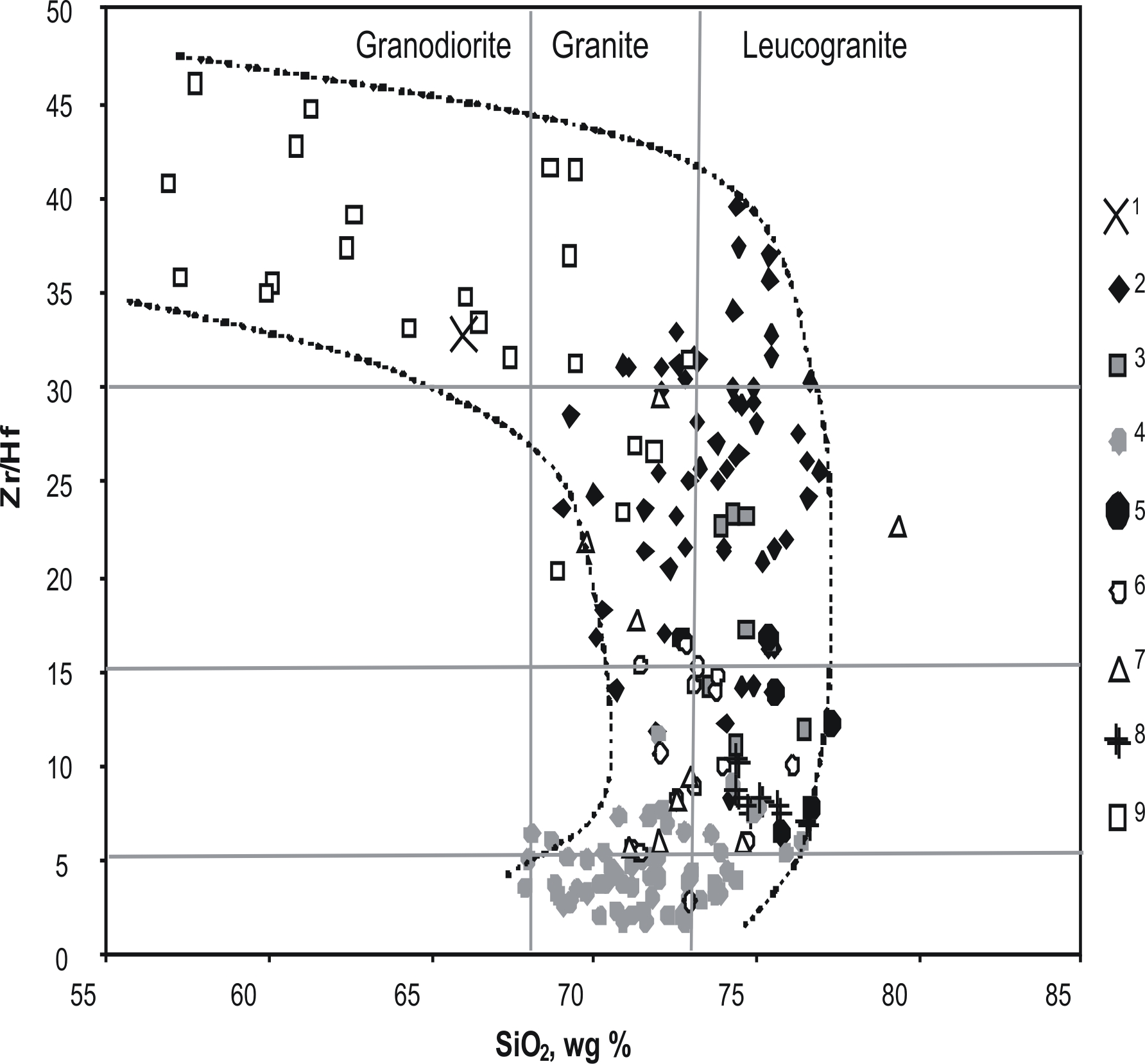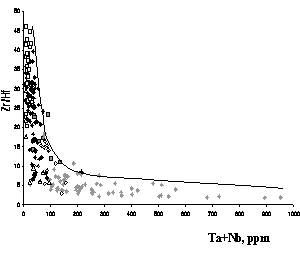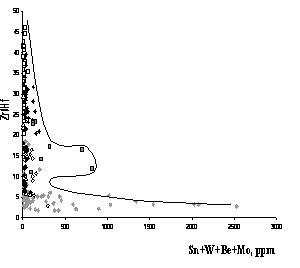|
PETROCHEMICAL EVIDENCE OF THE GRANITE CRYSTAL FRACTIONATION OF THE KUKULBEY RARE METAL COMPLEX OF THE EAST TRANSBAIKALIA
Zaraisky G.P.*, Aksyuk A.M.*, Chevychelov V.Yu.*, Udoratina O.V.** *Institute of Experimental Mineralogy RAS, Chernogolovka, Moscow region, Russia, zaraisky@iem.ac.ru **Institute of Geology of Komi SC UrD RAS, Syktyvkar, Russia, udoratina@geo.komisc.ru
It is known that only multiphase granite plutons are ore bearing for rare-metal mineralization. The typical Kukulbey complex of rare-metal granite of the East Transbaikalia (J3) is, in own way, unique on the achieved depth of fractionation of parent granite melt with display of phases of granite intrusions and them vein derivatives. Biotite granite of the 1-st phase is barren. With leucogranites of the 2-nd phase are connected the greisen Sn-W deposits (Spokoinoe, etc.). Final dome-shaped stocks of amazonite Li-F granite of the 3-rd phase contains in the top part of ones the Ta deposits of an "apogranite" type: Orlovka, Etyka, Achikan. All granite rocks of the complex are close on absolute age 142 ± 0.6 million years (Kostitsyn, et al, 2000).
Fig. 1. Trend of granitoid differentiation of the Kukulbey and Shakhtama complexes on the Zr/Hf-SiO2-diagram. 1 – the upper lcrust; 2-8 – the Kukulbey complex: 2 – biotite granite, 3 – muscovite granite, 4 – Li-F granite of Ta deposits, 5 - Li-F granite of the Turga stocks, 6 – ongonite, 7 – elvane, 8 – chamber pegmatite, 9 – the Shakhtama granite and granodiorites. In the Kukulbey granite complex the standard trend of crystal differentiation is poorly developed, because of the primary subeutectic composition. An appreciable increase of SiO2 is impossible for these rocks only due to loss of femic and calcium components during melt crystallization. Their crystallization occurs in a subeutectic mode, therefore on the Zr/Hf – SiO2 diagram, offered by us (Zaraisky, etc., 2000), the trend of the Kukulbey granite differentiation has subvertical orientation almost perpendicular to a trend of rocks of the Shakhtoma complex (Fig. 1). According to regular reduction of the Zr/Hf ratio in the rocks from 40 up to 2, the severe sequence of crystal fractionation is established: biotite and two-mica granites → muscovite leucogranite of the Spokoinoe, etc. deposits → amazonite Li-F granite of the Orlovka and Etyka deposits. The continuity of the trend confirms genetic unity of all granite rocks of Kukulbey complex and formation of leucogranite of the 2-nd phase and the Li-F granite of the 3-rd phase as result by crystal fractionation of melt of the parent biotite granite of the 1-st phase. Figurative points of oreless amazonite granite of the Turga stocks, ongonite, elvane, and pegmatite get in area between muscovite and Li-F granite. The role of the total Zr/Hf ratio in rocks as indicator of a fractionation index is caused by the stronger affinity of Hf to granite melt, than Zr- which leaves from melt together with zircon.
Fig.2.
Concentrating
of Ta and Nb in granitoids of the Kukulbey and Shakhtoma complexes
during fractionation process. Fig.3.
Two levels of W, Sn, Be, and Mo concentrating in granitois of the
Kukulbey complex. The work was supported by RFBR projects: 08-05-00835, 08-05-00865 and project SS-3763.2008.5 “Leader Scientific Schools” Reference Zaraisky G.P., Aksyuk A.M. Seltmann R. Fedkin A.V. Evolution of rare metal granite and Zr/Hf ratio as an indicator of its differentiation // Proceeding of the II Russian petrographic conference. Syktyvkar. 2000. V. III, P.47-50 (in Russian) Zaraisky G.P., Aksyuk A.M., Chevychelov V.Yu., Korzhinskaya V.S., Kotova N.P. Borodulin G.P., Udoratina O.V. Physical-chemical genetic model of tantalum deposits related to LiF granite // Proceeding of Scientific Conference devoted 100-age of acad. Chukhrov. M.: IGEM RAS, 2008, P.74-77 (in Russian) Kostitsyn Yu.A., Zaraisky G.P., Aksyuk A.M., Chevychelov V.Yu. Rb-Sr isotope evidence of genetic unity of biotite and Li-F granites as an illustration of the Spokoinoe, Orlovka, and Etyka deposits // Gekhimiya, No 9. 2004, P.940-948 (in Russian)
|


